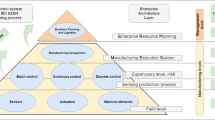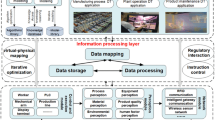Abstract
The vibration of the rolling mill has been a persistent issue affecting its safe and stable operation. To address the vibration problem in the F2 stand of a continuous rolling mill, this paper establishes a digital twin model of the rolling mill. Based on the digital twin model, a rolling mill virtual commissioning framework has been proposed to enhance the accuracy of real-time data and improve the utilization of production data, laying the foundation for reducing vibration during the operation of the rolling mill. In this process, we first construct a digital twin framework for the rolling mill, consisting of four levels: physical rolling mill, virtual rolling mill, twin data, and services. Next, an online data acquisition and virtual commissioning framework is established to achieve a state mapping from the physical rolling mill to the virtual rolling mill. Finally, using the digital twin model, the effects of real-time process parameter optimization are analyzed. The impact of process parameter optimization on the dynamic response of the rolling mill system is examined. The optimized rolling process parameters effectively reduce the vertical vibration of the rolling mill system.










Similar content being viewed by others
References
Grieves MW (2005) Product lifecycle management: the new paradigm for enterprises. Int J Prod Dev 2(1/2):71. https://doi.org/10.1504/IJPD.2005.006669
Tao F, Qi Q (2019) New IT driven service-oriented smart manufacturing: framework and characteristics. IEEE Trans Syst Man Cybern Syst 49(1):81–91. https://doi.org/10.1109/tsmc.2017.2723764
Tao F, Qi Q (2019) Make more digital twins. Nature 573(7775):490–491. https://doi.org/10.1038/d41586-019-02849-1
Zhang Y, Wang WZ, Zhang H, Li HC, Liu CR, Du XZ (2022) Vibration monitoring and analysis of strip rolling mill based on the digital twin model. Int J Adv Manuf Technol 122:3667–3681
Schamp M, Hoedt S, Claeys A, Aghezzaf EH, Cottyn J (2018) Impact of a virtual twin on commissioning time and quality. IFAC Papers On Line 51(11):1047–1052
Mortensen ST, Madsen O (2018) A virtual commissioning learning platform. Procedia Manuf 23:93–98
Lechler T, Fischer E, Metzner M, Mayr A, Franke J (2019) Virtual commissioning-scientific review and exploratory use cases in advanced production systems. Procedia CIRP 81:1125–1130
Ko M, Ahn E, Park SC (2013) A concurrent design methodology of a production system for virtual commissioning. Concurr Eng 21(2):129–140
Barnowski D, Dahmen M, Farkas T, Petring D, Petschke U, Pootz M, Schäl R, Stoyanov S (2022) Multifunctional laser processing with a digital twin. Procedia CIRP 2022:822–826
Mykoniatis K, Harris GA (2021) A digital twin emulator of a modular production system using a data-driven hybrid modeling and simulation approach. J Intell Manuf 2021:1899–1911
Lu SX, Ma CH, Hu TL (2022) Virtual Commissioning of Force-power Controlled Press Machine Based on Digital Twin. J Chin Comput Syst 43(07):1356–1361. https://doi.org/10.20009/j.cnki.21-1106/TP.2022-0057
Wang Q, Huang P, Yin YH (2021) Design and optimization of rolling mills pass based on parameterization and orthogonal test. Int J Adv Manuf Technol 112:803–818. https://doi.org/10.1007/s00170-020-06353-z
Evin E, Tomáš M, Kmec J (2020) Optimization of electro-discharge texturing parameters for steel sheets’ finishing rollers. Materials 13(5):1223. https://doi.org/10.3390/ma13051223
Jung C, Zaefferer M, Bartz-Beielstein T, Rudolph G (2017) Metamodel-based optimization of hot rolling processes in the metal industry. Int J Adv Manuf Technol 90:421–435. https://doi.org/10.1007/s00170-016-9386-6
Hu SD, Wang C, Wang XY, Li LX, Liu S (2022) Process optimization of planetary rolling of bismuth-containing austenitic stainless steel. J Mater Eng Perform 31:2012–2022. https://doi.org/10.1007/s11665-021-06356-1
Gao ZY, Tian B, Liu Y, Zhang LY, Liao ML (2021) Dynamics-based optimization of rolling schedule aiming at dual goals of chatter suppression and speed increase for a 5-stand cold tandem rolling mill. J Iron Steel Res Int 28:168–180. https://doi.org/10.1007/s42243-020-00551-5
Wang Y, Li CS, Jin X, Xiang YG, Li XG (2020) Multi-objective optimization of rolling schedule for tandem cold strip rolling based on NSGA-II. J Manuf Process 60:257–267. https://doi.org/10.1016/j.jmapro.2020.10.061
Wang LP, Zhu QY, Zhao HY (2020) Optimization design of a novel X-type six-high rolling mill based on maximum roll system stiffness. PLoS One 15(2):e0228593. https://doi.org/10.1371/journal.pone.0228593
Martin M, Andreas S, Katharina P, Andreas K (2018) Optimal Parameter Identification for a Hydrodynamic Roll Gap Model in Hot Strip Rolling. IFAC-PapersOnLine 51:195–200. https://doi.org/10.1016/j.ifacol.2018.09.417
Chen Y, Wang AQ, Tian HW, Xie JP, Wang X (2021) Study on optimization of nozzle for copper-aluminium clad plate twin-roll cast-rolling. J Market Res 10:1075–1085. https://doi.org/10.1016/j.jmrt.2020.12.088
Wang PF, Wang HF, Li X, Zhang DH, Li WT, Yao YL (2021) A double-layer optimization model for flatness control of cold rolled strip. Appl Math Model 91:863–874. https://doi.org/10.1016/j.apm.2020.09.028
Prinz K, Steinboeck A, Kugi A (2018) Optimization-based feedforward control of the strip thickness profile in hot strip rolling. J Process Control 64:100–111. https://doi.org/10.1016/j.jprocont.2018.02.001
Müller M, Prinz K, Steinboeck A, Schausberger F, Kugi A (2020) Adaptive feedforward thickness control in hot strip rolling with oil lubrication. Control Eng Pract 103:0967–661. https://doi.org/10.1016/j.conengprac.2020.104584
Hu YJ, Sun J, Peng W, Zhang DH (2021) Nash equilibrium-based distributed predictive control strategy for thickness and tension control on tandem cold rolling system. J Process Control 97:92–102. https://doi.org/10.1016/j.jprocont.2020.11.014
Funding
The authors are grateful for the support of the National Natural Science Foundation of China (Grant No. 52375366), National Natural Science Foundation of China (Grant No. 51905365), Grant From of Shanxi Major Science and Technology Projects (Grant No. 20181102015), and Shanxi Province Excellent Graduate Innovation Project (Grant No. 2021Y671).
Author information
Authors and Affiliations
Contributions
All authors contributed to the study’s conception and design. Material preparation and data collection were performed by Yang Zhang, digital twin modeling and analysis by Yijian Hu, communication system construction by Huan Zhang and Weizhong Wang, optimization algorithm establishment by Xingwang Ma, and material curation by Xiaozhong Du to proceed and all authors commented on previous versions of the manuscript. All authors read and approved the final manuscript.
Corresponding author
Ethics declarations
Competing interests
The authors declare that they have no competing interests.
Additional information
Publisher's Note
Springer Nature remains neutral with regard to jurisdictional claims in published maps and institutional affiliations.
Rights and permissions
Springer Nature or its licensor (e.g. a society or other partner) holds exclusive rights to this article under a publishing agreement with the author(s) or other rightsholder(s); author self-archiving of the accepted manuscript version of this article is solely governed by the terms of such publishing agreement and applicable law.
About this article
Cite this article
Hu, Y., Zhang, Y., Ma, X. et al. Virtual commissioning and process parameter optimization of rolling mill based on digital twin. Int J Adv Manuf Technol 130, 705–716 (2024). https://doi.org/10.1007/s00170-023-12718-x
Received:
Accepted:
Published:
Issue Date:
DOI: https://doi.org/10.1007/s00170-023-12718-x




